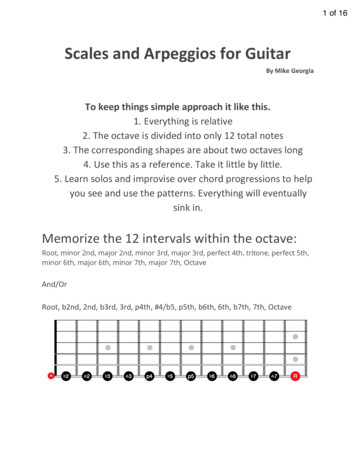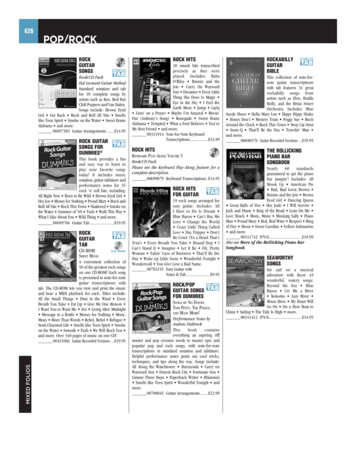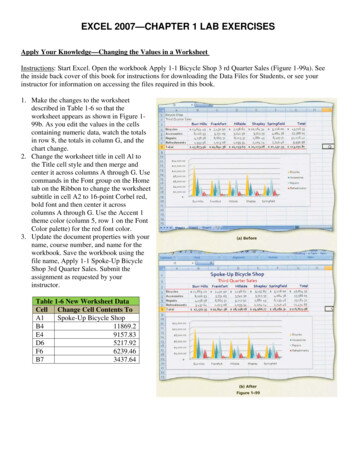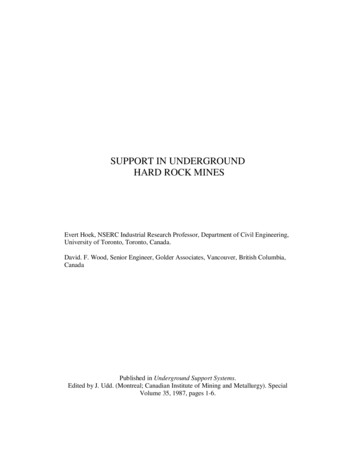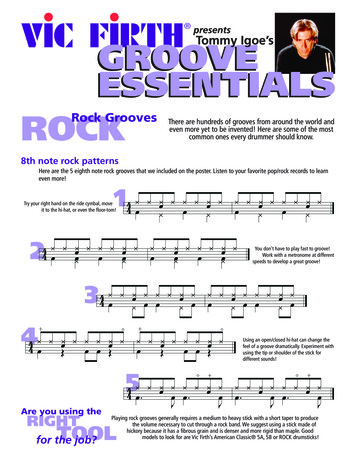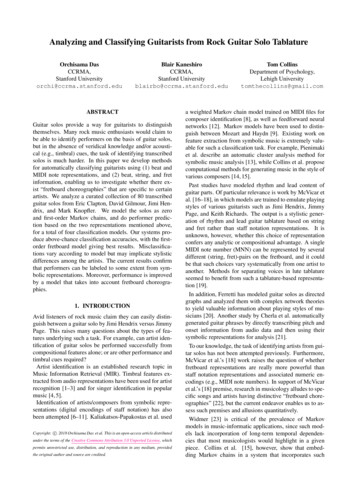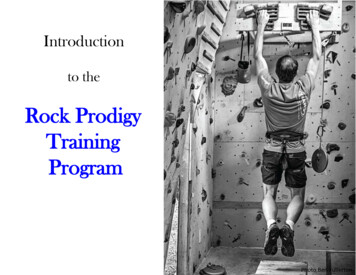
Transcription
Introductionto theRock ProdigyTrainingProgramPhoto Ben Fullerton
OverviewIntroductionThe Case for TrainingTraining vs. Skill DevelopmentPeriodization OverviewTraining PhasesThe Rock Climber’s TrainingManual Questions Photo Mark Anderson
About Me Not a ‘Phenom’ – I spent 9 years struggling 5.10 I ‘got serious’ at 23; I managed to climb 5.12 after 18months of regular gym climbing, but I suffered 3 serious fingerinjuries alongthe way andplateau-ed Then my brotherMike turned meon to training
Why Improve at Climbing? Increased Access: The better you are, the more routesare available– Furthermore, harder routes are often justplain better!– Elite climbers can still climb moderateroutes, but not vice versa Time Value of Climbing Ability: Evenif you don’t aspire to harder routes,easier routes can be climbed morequickly, thus leaving more time toclimb other routes! Increased Enjoyment: Like any movement-based sport,climbing ‘feels better’ when donewell The joy of setting a goal, workinghard to achieve it, and executingunder pressurePhoto Jason Hundhausen
The Case for Training The best way to improve over the long run– Solves the “plateau” problem that results from “justclimbing”– Allows you to measure workload and incrementallyincrease it to force physical adaptation & reduce injury risk– Results in a highly motivating empirical record ofimprovement Saves time– Can be done solo, at home, or wherever is most convenient– Muscular failure can be achieved far quicker within asystematic program– Good training programs demand lots of rest
Training vs. Skill DevelopmentOften beginners are told not to train becausethey should focus on ‘learning how to climb’ Most of the time, once these climbers have decidednot to train, they still don’t know how to learnclimbing movement skills Training and Skill Development are NOT mutuallyexclusiveA well-designed training program provides structuredopportunities for regular, progressive skill development, whilealso improving physical weaknesses
PeriodizationThe Rock Prodigy method is a form of Periodization -- a strategyfor physical training in which different training activities are performed in accordancewith a carefully designed schedule to achieve a synergistic effect on overallperformance that results in a performance peak at a predictable time.
Training PhasesA Periodic training program utilizes a series of relativelydistinct training ‘phases’, that are organized into asingle ‘season’: Base FitnessStrengthPowerPower EndurancePerformanceRest
Base Fitness The Base Fitness Phase serves several purposes:– Lays a foundation for the ensuing training phases– Provides the ideal atmosphere for focused skill development– Increases capillarity & blood flow in the climbing muscles, thusimproving recovery between workouts/performances– Trains themuscle’smetabolicpathways toimproveendurance byincreasing theclimber’smaximum steadystate
ARC Training Aerobic Restoration and Capillarity (ARC) Training– Primary training activity during the Base Fitness Phase– Usually performed by ‘traversing’indoors, low to the ground, sans rope– Workout entails 2-3 sets of 20-45minutes of continuous climbing at orjust below the MSS– Focus on Skill Development, recovery,and grip control– Used to raise the MSS, improvecapillarity, & prep for Strength Phase– Ideal for acquiring/refining movementskills and improving grip control– Used outside Base Fitness Phase towarm-up/cool-down & aid recoveryPhoto Fred Marmsater
StrengthTargets improvements in muscular force productionthrough hypertrophy (muscle growth) and neurologicaladaptations Finger Strength and Whole Body Strength Achieved by isolating key muscle groups and systematicallyexercising to failure Isotonic vs Isometric Contractions
Hangboard Training The best method for improving isometric finger strength– Allows for simple isolation of specific grips– Easy to control, quantify, and documentloads, enabling the athlete to give maxeffort while minimizing injury risk– Apparatus is compact and even portable Workout entails multiple exercises ofseveral sets of static dead-hangs (akarepetitions/reps)– Perform 6-10 Exercises or Grip Positions– Perform 1-3 Sets of each Exercise– Perform 5-7 Reps within each setPhoto Fred Marmsater
Whole Body Strength Training Supplement to Finger Strength Training Trains associated muscles that contribute toclimbing performance– Pull/Lock-off Muscles– Pushing Muscles– Core– Shoulders– Upper ArmsPhoto Fred Marmsater
Power Climbing is a dynamic sport; staticstrength alone is insufficient Power is the ability to generatelarge force quickly Power Training seeks to improvecontact strength Achieved by improving finger flexorcontraction speed Must force muscles to contractquickly in trainingPhoto Brian Mosbaugh
Limit Bouldering & Campusing Limit Bouldering: short problems featuring 1-2dynamic moves right at the climber’s limit Campusing: footless dynos performedon a ladder of like wooden “rungs” Both improve contact strength Both improve dynamic accuracy &aggressiveness LB is more sport-specific Campusing is easier to isolate specificgrips, control, quantify & documentPhoto Fred Marmsater
Power Endurance The ability to perform multiplenear-maximal climbing moveswithout rest (for 1-4 minutes) Essential to route climbing, tocope with forearm pump PE Training improves metabolicpathways of both slow and fasttwitch muscle fibersPhoto Janelle Anderson– Linked Bouldering Circuits (LBCs)– Route Intervals– Skill Stress-Proofing
Rest Supercompensation: Training makes you weaker!Recovery from training makes you stronger Smarter, not harder!– Don’t train to make you tired; train to make you better Micro-scale: Rest Days within a season:–––––Massage/Stretching/Icing as requiredBrief, light exercise (brisk hike, 1 hr or less)Visualization/Beta reviewSleep & NutritionSkin Care Macro-scale: Rest Days/Weeks between seasons:– Reflect on previous season & plan goals/training for next season– Regular non-climbing general conditioning exercise– Re-charge motivation & enjoy life away from climbing!
Other Factors Injury Prevention & RehabilitationGoal Setting & PlanningSkill DevelopmentWeight ManagementStrategy & TacticsFocus & IntensityPhoto Andrew Burr
Get the Book!http://rockclimberstrainingmanual.com
The Rock Climber’s Training Manual
ARC Training Aerobic Restoration and Capillarity (ARC) Training – Primary training activity during the Base Fitness Phase – Usually . performed by ‘traversing’ indoors, low to the ground, sans rope – Workout entails . 2-3 sets of 20-45 minutes of continuous climbing . at or just below the MSS – Focus on . Skill Development, recovery, andFile Size: 2MBPage Count: 20
